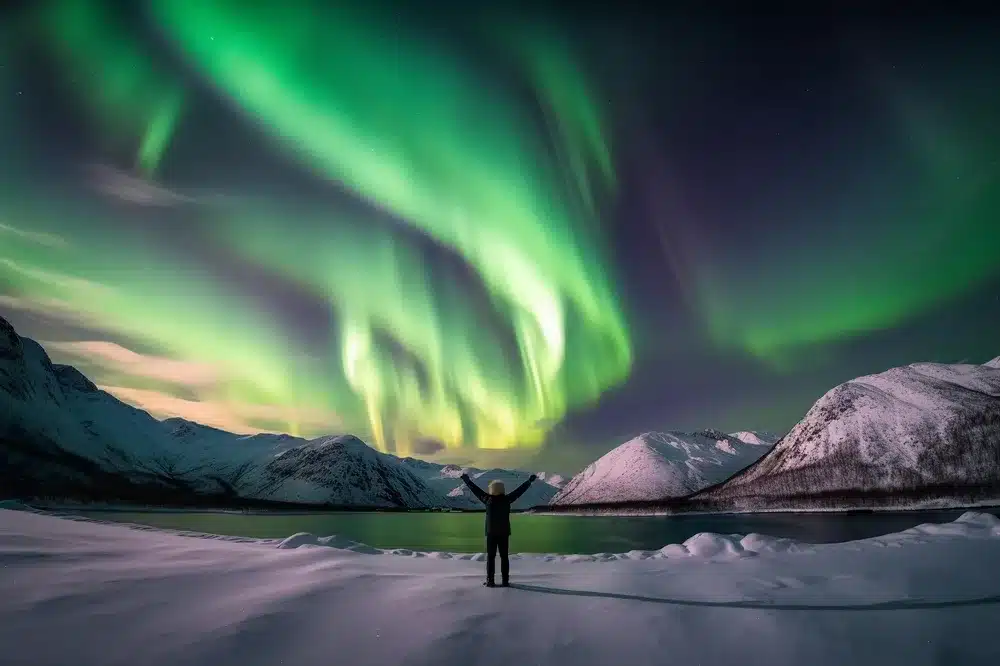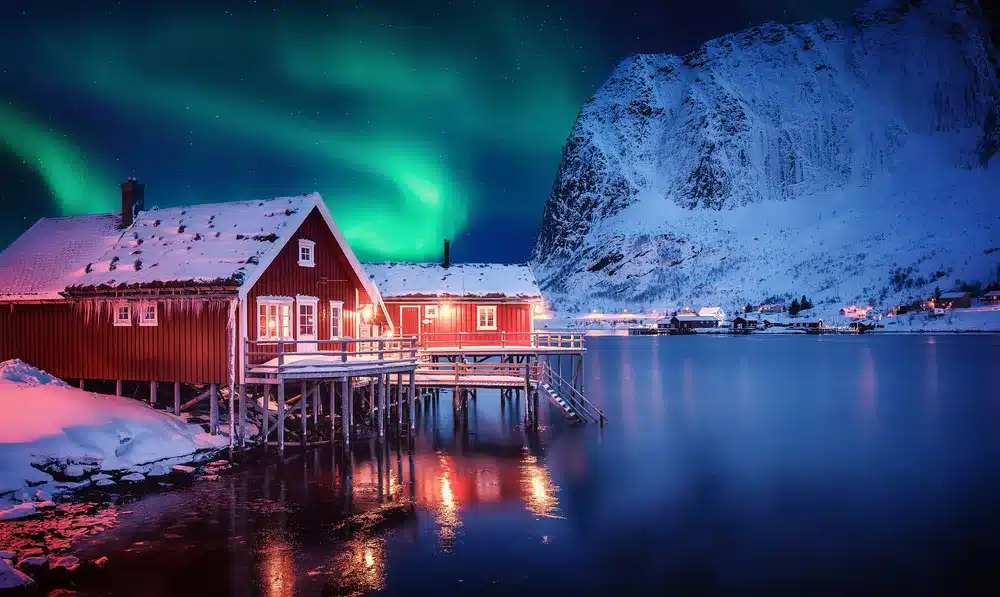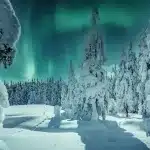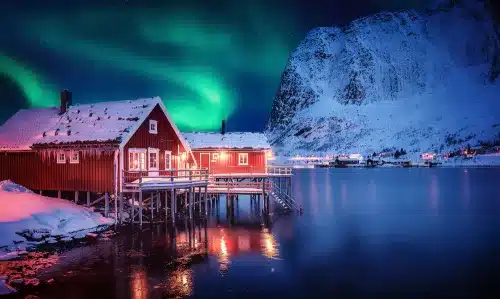
The mesmerising display of swirling lights, known as the Northern Lights or aurora borealis, has captivated many people. This natural phenomenon has fascinated humans for centuries, but what exactly causes it, and where is the best place in Norway to witness this awe-inspiring sight? In this informative blog post, we will probe into the science behind the Northern Lights and explore the top locations in Norway where you can experience this magical spectacle firsthand.
9 ways to explore the Norwegian Midnight Sun
In this article, we are giving you the following 11 amazing facts about the Northern Lights and where to see them in Norway
Key Takeaways:
- The Northern Lights, or aurora borealis, appear as bright, swirling curtains of lights in the night sky and range from green to pink and scarlet.
- They are caused by charged particles from the Sun hitting gases in the Earth’s atmosphere. They are most commonly seen in regions close to the North Pole, such as Scandinavia, Greenland, Alaska, Canada, and Russia.
- The best places in Norway to see the Northern Lights include Tromsø, Kirkenes, Narvik, Lofoten, Svalbard, and Bodø, with ideal conditions and high chances of witnessing this stunning natural phenomenon.
- For the best chances of seeing the Northern Lights in Norway, visitors should travel further north, such as Tromsø, and plan to stay for at least five days during winter.
- The Northern Lights are most visible around the equinoxes of March-April and September-October, with the brightest displays typically occurring around 11 pm to midnight local time. Professional photographers may enhance displays to capture their full beauty.
The Best Free Attractions in Oslo
1. What are the Northern Lights?
Scientific Explanation
Lights in the night sky, known as the Northern Lights or aurora borealis, are a breathtaking natural phenomenon caused by charged particles from the Sun interacting with gases in the Earth’s atmosphere. Different gases emit varying colours when energised, with oxygen producing green lights and nitrogen emitting purple, blue, and pink hues. These stunning light curtains are most frequently seen in regions near the North Pole.
Myths and Folklore
What do ancient cultures believe about the mesmerising display of lights in the night sky? Myth and folklore surrounding the Northern Lights are rich and varied. In Norse mythology, the lights were thought to reflect the armour of the Valkyries, warriors who chose slain heroes to enter Valhalla. In Finnish folklore, the lights were seen as magical fox fires, while some indigenous cultures believed the lights were spirits of ancestors dancing in the sky.
The Aurora in Popular Culture
The Northern Lights have long captivated people’s imaginations, reflecting their ethereal beauty and mystical allure. The aurora borealis has inspired countless art, literature, and film works from ancient myths to modern-day interpretations. Its colourful and dynamic display fascinates and enchants audiences worldwide, making it a prominent motif in popular culture.
Essential Photography Tips for Chasing the Northern Lights
2. What Causes the Northern Lights?

Find even more Facts and fiction about the northern lights here
The Sun’s Role
The Sun’s activity is key in forming the mesmerising Northern Lights. When the Sun emits charged particles in coronal mass ejections, they travel towards Earth and interact with our planet’s magnetic field.
Earth’s Magnetosphere
Earth’s magnetic field, also known as the magnetosphere, plays a crucial role in the appearance of the aurora borealis. When the charged particles from the Sun reach the Earth’s magnetosphere, they are redirected towards the polar regions, where they collide with gases in the atmosphere.
Solar Wind Interactions
What triggers the stunning display of the Northern Lights is the interaction between the solar wind, a stream of charged particles emitted by the Sun, and the gases in the Earth’s atmosphere. These interactions create glowing curtains of light that dance across the sky in polar regions.
The Sun’s activity, Earth’s magnetosphere, and interactions with the solar wind all contribute to the magical Northern Lights, which captivate observers in regions close to the Earth’s poles.
3. What Are the Colors of the Aurora
Many enthusiasts are captivated by the dazzling array of colours displayed in the sky during the Aurora Borealis. Understanding the factors influencing these colours can enhance the awe-inspiring experience of witnessing this natural phenomenon.
Factors Influencing Aurora Colors
- The altitude at which charged particles collide with gases in the Earth’s atmosphere
- The type of gas being energised (oxygen atoms emit green, while nitrogen atoms emit purple, blue, and pink)
- The energising process that increases the intensity and hue of the colors
Knowing these factors can provide insight into the variance in colour patterns observed during the Northern Lights phenomenon.
Spectral Analysis of the Lights
For an in-depth understanding of the Aurora Borealis colours, spectral analysis can reveal the specific wavelengths of light emitted by energised gases in the atmosphere. This analysis offers valuable data on the composition and behaviour of the elements contributing to the vibrant display of colours.
Common Color Patterns
Colours observed in the aurora borealis follow typical patterns based on the energised gases and the altitude at which the interaction occurs. The most common colours seen are green, purple, blue, and pink, each associated with specific atmospheric conditions and solar activity. The intensity and distribution of these colours create a mesmerising spectacle in the night sky.
4. Why View the Northern Lights in Norway?
Geographic Advantages
Norway’s advantages for viewing the Northern Lights include its location in the auroral zone, which provides prime conditions for witnessing this spectacular natural phenomenon. Also, Check out this article for the best time and place to see the Northern Lights in Norway.
Seasonal Visibility
An ideal time to see the Northern Lights in Norway is around the equinoxes, typically in March-April and September-October. This is when magnetic storms are more frequent, enhancing the chances of witnessing the auroras in their full glory. The unique geographic position of Norway, near the North Pole, makes it a perfect spot for experiencing this celestial display.
Daily Forecasting
Seasonal solar activity variations impact the daily visibility of the Northern Lights in Norway. For the brightest displays, aim to view them around 11 pm to midnight local time, with clear skies enhancing the viewing experience. Professional photographers often capture stunning images of the auroras by adjusting camera settings to capture more light.
You can see the aurora borealis forecast here
The 5 Most Famous Norwegian Fjords
5. What Are the Best Places to see the Northern Lights in Norway

Tromsø: The Gateway to the Arctic
Not just a vibrant urban hub, Tromsø is also regarded as one of the best places in the world to witness the northern lights. Located in the Arctic Circle, visitors spending five or more days during winter have a decent chance of experiencing this natural phenomenon. Fjellheisen Mountain offers a prime viewing platform to catch the dancing lights in the sky.
Kirkenes:
With an impressive 200 aurora borealis nights annually, Kirkenes offers ample opportunities to catch the dancing lights. The optimal conditions here ensure a high likelihood of witnessing this natural phenomenon.
Bodø:
Just a stone’s throw from Rønvikfjellit Mountain, Bodø offers unparalleled night sky views. Find a spot with an unobstructed view and prepare to be mesmerised by the celestial display overhead.
Narvik:
The Narvik region is situated directly beneath the Northern Lights oval and offers prime viewing opportunities. Embark on the Northern Lights Express, traversing the world’s northernmost railway line amidst the mountainous landscape, far from the glare of city lights.
The Lofoten Islands: Aurora and Landscape
Norway’s picturesque Lofoten Islands provide stunning landscapes and a chance to witness the Northern lights in all directions. With mountains creating gaps in the cloud cover, even on cloudy days, the islands offer a unique vantage point to experience the luminous dance of the auroras against the Arctic backdrop.
Svalbard: Norway’s High Arctic Archipelago
The Svalbard archipelago between mainland Norway and the North Pole provides exceptional conditions for witnessing the aurora borealis. Known for its polar nights and unique Arctic landscapes, Svalbard offers a magical setting to observe this celestial display. With 200 aurora borealis nights per year, visitors have ample opportunities to marvel at the lights.
6. When Is the Optimal Time to Experience the Aurora Borealis?
Exploring Norway: A Tourist’s Guide to Adventure and Discovery
Monthly Variations in Visibility
Every month, the best times to witness the northern lights in Norway are around the equinoxes in March-April and September-October. During these periods, there tend to be more magnetic storms, leading to a higher frequency of displays. But it is possible to see the aurora borealis throughout the whole winter. It can be seen best at night with a clear sky, typically around 11 pm to midnight local time.
Best Viewing Conditions
Conditions play a crucial role in experiencing the northern lights at their best. For instance, experts recommend finding areas away from light pollution, especially in regions close to the North Pole, like Scandinavia, Greenland, Alaska, Canada, and Russia. The higher the solar activity, the greater the chances of witnessing this stunning natural phenomenon.
Long-Term Solar Cycle Effects
The long-term solar cycle also impacts the visibility of the northern lights. The Sun’s activity influences displays’ frequency and intensity, with more significant coronal mass ejections resulting in broader areas of aurora activity. In regions like Tromsø and Kirkenes in Norway, known for ideal conditions, visitors have plenty of opportunities to catch the lights throughout the year due to their strategic locations below the Northern Lights oval.
7. The Aurora Borealis Versus the Northern Lights

Defining Each Term
Discussions about the aurora borealis and the northern lights require a clear understanding of these terms. The aurora borealis, also known as the northern lights, is a natural light display in the Earth’s sky predominantly seen in high-latitude regions like Scandinavia, Alaska, and Canada. On the other hand, the term northern lights refers explicitly to the phenomenon when seen in the northern hemisphere.
Similarities and Differences
To distinguish between the aurora borealis and the northern lights, it’s vital to note that they refer to the same celestial event but in different geographical contexts. The southern lights, or aurora australis, are the counterpart to the northern lights and occur near the South Pole, visible in regions like Antarctica. Both phenomena are caused by charged particles from the Sun interacting with the Earth’s magnetic field, creating mesmerising light displays in the night sky.
Global Displays of the Aurora Borealis
To explore the global displays of the aurora, we see the aurora borealis predominantly in regions close to the North Pole, including Scandinavia, Greenland, Alaska, Canada, and Russia. Similarly, the aurora australis is visible in locations near the South Pole, such as Antarctica. The most spectacular displays of these phenomena occur during heightened solar activity, resulting in stunning light shows extending towards the equinoxes in March-April and September-October.
8. What Should You Pack And How Should You Plan Your Northern Lights Trip?
Preparing for the Arctic Climate
Lights can be deceiving in the Arctic climate. While the northern lights provide a magical display in the sky, the temperatures in these regions can be extreme. Packing warm, layered clothing is essential to protect yourself from the cold.
Necessary Equipment and Clothing
Climate-appropriate gear is crucial for a successful Northern Lights trip. Along with thermal clothing, insulated boots, and gloves, consider investing in a good-quality camera with a tripod for capturing the awe-inspiring lights dancing in the sky.
Organising Accommodations and Tours
Research and planning are essential when organising accommodations and tours for your Northern Lights expedition. Book your stay in advance in popular viewing spots like Tromsø, Kirkenes, or Svalbard, and consider guided tours for an enhanced experience under the expert guidance of local aurora chasers.
Here are some suggestions for guided Aurora Borealis tour operators:
Photography Tips for Capturing the Aurora
- Choose a sturdy tripod to keep your camera stable during long exposures.
- Adjust your camera settings to a high ISO and wide aperture for better low-light photography.
Northern Lights photography requires a combination of skill and patience to capture the ethereal beauty of the aurora. Selecting the correct camera settings and framing your shots creatively can lead to stunning photographs. Perceiving the interaction of light and landscape is crucial in capturing the essence of the Northern Lights.

9. Sustainability and the Northern Lights Experience
Preserving Norway’s Pristine Environments
Sustainability is crucial in preserving Norway’s pristine environments while enjoying the breathtaking Northern Lights. The fragile ecosystems in the northern regions, such as Tromsø and Lofoten, must be protected to ensure the continued beauty of this natural wonder. Visitors are encouraged to travel responsibly, minimise environmental impact, and respect local regulations to preserve these stunning landscapes.
Responsible Aurora Tourism
Sustainability is critical to ensuring responsible Aurora tourism in Norway. By choosing eco-friendly accommodations, supporting local businesses, and following Leave No Trace principles, travellers can minimise their carbon footprint and contribute to the region’s long-term sustainability. Engaging in activities that prioritise environmental conservation while experiencing the magic of the Northern Lights is crucial.
Tourism that respects the local culture and environment is crucial in preserving the authenticity of the Aurora Borealis experience. By partnering with tour operators who prioritise sustainable practices and engage in community-based initiatives, travellers can ensure their visit benefits the local communities and helps protect Norway’s unique ecosystems.
10. Additional Experiences While Chasing the Aurora Borealis
Dog Sledding and Snowmobiling
Chasing the Northern Lights in Norway offers more than a dazzling light show. Experience the thrill of dog sledging and snowmobiling through the pristine Arctic wilderness. With over 200 Aurora Borealis nights per year in some regions, you have plenty of opportunities to combine your aurora hunt with these exciting winter activities.
Indigenous Sami Culture
Aurora hunting in Norway also provides a unique chance to immerse yourself in the indigenous Sami culture. While on your quest to witness the Northern Lights, take a deeper look into the rich traditions, folklore, and lifestyle of the Sami people. Learn about their reindeer herding practices, traditional crafts, and unique way of life in the Arctic.
Norwegian Cuisine and Accommodation
Any trip to Norway to see the Northern Lights is incomplete without indulging in delicious Norwegian cuisine and experiencing authentic accommodation options. Sample local delicacies such as hearty stews, fresh seafood, and delicious desserts to complement your aurora-viewing experience. Stay in cosy cabins, luxury igloos, or traditional Sami tents for a genuinely immersive Arctic adventure.
11. Myths and Mysteries of the Aurora

Legends from Around the World
Legends worldwide offer fascinating explanations for the stunning phenomenon known as the Northern Lights. In Finnish mythology, the aurora borealis is said to be caused by Firefox dashing across the snow, creating sparks with its tail. Meanwhile, in ancient Greek mythology, the goddess Aurora raced across the sky to announce the arrival of the Sun.
Scientific Discoveries and Theories
Theories surrounding the Northern Lights have long fascinated scientists. The lights are caused by charged particles from the Sun colliding with gases in the Earth’s atmosphere, producing a mesmerising display of colours. Recent scientific discoveries have shown that solar wind interacting with the Earth’s magnetic field is necessary for forming the auroras.
The Aurora in Literature and Art
Auroras have captivated artists and writers throughout history. In literature, the Northern Lights have been portrayed as mystical and enchanting, often symbolising a connection between the earthly and the divine. Artists like Vincent van Gogh have also been inspired by the beauty of the auroras, incorporating their vibrant colours and swirling patterns into their works.
To wrap up, the Northern Lights, or aurora borealis, are a spectacular natural phenomenon caused by charged particles from the Sun interacting with gases in the Earth’s atmosphere. The best places to see the Northern Lights in Norway include Tromsø, Kirkenes, Narvik, Lofoten, Svalbard, and Bodø. These regions offer ideal conditions for witnessing this mesmerising display of lights in the night sky. For the best chances of seeing the Northern Lights, visit these northern regions of Norway during the winter season and on clear nights. Whether you are a seasoned aurora chaser or a first-time viewer, experiencing the Northern Lights in Norway will surely be a memorable and awe-inspiring adventure.
FAQ
5 Ways to Explore the Diverse Flavors of Delicious Norwegian Cuisine
-
What are the Northern Lights?
The Northern Lights, also known as aurora borealis, are a natural phenomenon characterised by glowing light curtains in the night sky. These lights appear in various colours, such as green, pink, and scarlet.
-
What causes the Northern Lights?
The Northern Lights are caused by charged particles from the Sun interacting with gases in the Earth’s atmosphere. When the solar wind carrying these particles interacts with the Earth’s magnetic field, it creates a stunning display of the aurora borealis.
-
Why do Northern Lights appear in different colours?
Different gases in the Earth’s atmosphere produce different colours when energised. Oxygen atoms emit green light, the most common colour in the Northern Lights, while nitrogen atoms emit purple, blue, and pink hues.
-
Where is the best place to see the Northern Lights in Norway?
The best places in Norway to witness the Northern Lights include Tromsø, Kirkenes, Narvik, Lofoten, Svalbard, and Bodø. These locations offer optimal conditions and sightlines for viewing this spectacular natural phenomenon.
-
Which month is best to see the Northern Lights
The Northern Lights are most visible around the equinoxes in March-April and September-October when there are more magnetic storms. These periods offer increased chances of witnessing vibrant displays of the aurora borealis.
-
Is there a daily forecast for the Nordic Lights?
You can see the aurora borealis forecast here
How To Plan The Perfect Northern Lights Winter Getaway








